
Lifestyle/Community
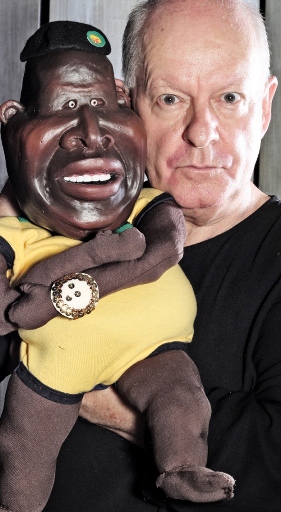
Robyn Sassen wraps up the week’s Arts
Published
10 years agoon
By
adminARTS EDITOR ROBYN SASSEN
Pictured at left is Samuel Bak’s 1992 oil on linen, Shema Yisrael
Dark humour provides Uys with bite in laugh
Theatre: “Adapt or Fly” by Pieter-Dirk Uys, Pieter Toerien Theatre, Montecasino Fourways, until November 8
REVIEWED BY ROBYN SASSEN
With the swagger induced by a hat, rosettes, a gesture of the finger or of the tongue, the remarkable Pieter-Dirk Uys does it again, in a more thoughtful, sinister version of a work we feel like we’ve seen before. Only we haven’t.
While many lines that get the big laughs reach back into his established repertoire, Adapt or Fly might be his darkest work yet. Arguably, it’s one that gets audiences laughing the most.
Uys’ shtick around the prime ministers and presidents that govern our country is riotously funny, on a trajectory of South African leadership from DF Malan to post-election 2014, revealing them – with the exception of Nelson Mandela – as evil, ugly and stupid.
His own life is interwoven into the narrative, though we’ve heard and read his story often; it always bears repetition.
But it is the transformation of Uys into all these characters who have populated South Africa’s history and shaped it, that is most hilarious and terrifying. Suddenly, PW Botha with his gesticulating finger and scowl is reincarnated in our presence, to say nothing of John Vorster with his eyebrows and chilling notorious coldness over Biko’s death.
In the second half, there’s Nowell Fine, the Jewish kugel whose life we’ve followed since she became “part of the chorus line” in 1985. She’s older; much of her flimsy hypocrisy has faded into cynicism.
With a pair of thick spectacles, she’s become a Sea Point-based bobba – a bit abandoned – and consequently more three-dimensional than ever. She’s on her way back from a high school reunion in Toronto and disappointed at the shallow fickleness of her migrated peers.
 Using the national anthems as poetic foils, the writing is crisply beautiful and filled with outrageous barbs.
Using the national anthems as poetic foils, the writing is crisply beautiful and filled with outrageous barbs.
You need to stave off the loudness of your laughter, so that you can hear each new turn and twist of political rhetoric and appreciate the light Uys shines on it.
PIC: Pieter-Dirk Uys with baby Juju. courtesy Buz Publicity
The show’s caveat takes us into the 2014 election and the horror of a new president we might vote in if we aren’t careful. An analogy is threaded through the work balancing Hitler with Julius Malema. Glorious Evita Bezuidenhout is fabulously present, but deeply insulted by events.
And then, an ageing Uys, steps beyond his caricaturing and masks, raises the house lights and looks the audience in the eye. He appeals to those younger than 25 who have not yet voted, to do the responsible thing and register to vote, and take ownership of this situation.
Adapt or Fly – a development from the title of his first work Adapt or Dye – sees Uys once again using the powers-that-be in government as his scriptwriters, but also with a vulnerability and an urgency we’ve not seen in him before. This tightly conceived, well-constructed piece will keep you on the edge, laughing at things that scare you most.
Spanoudes & Stephanou provide glimpse into Greek soul
Theatre: Double Bill: Soil by Renos Spanoudes and Meze Mira and Make-Up by Irene Stephanou, Auto & General Theatre on the Square (011) 883-8606 until November 23.
REVIEWED BY ROBYN SASSEN
Daphne Kuhn, owner and artistic director of Auto & General Theatre on the Square, has a flair for touching an audience’s cultural nerves. This double-bill which she has produced, celebrates Greek cultural cringe from two extraordinarily crafted angles, which couple well.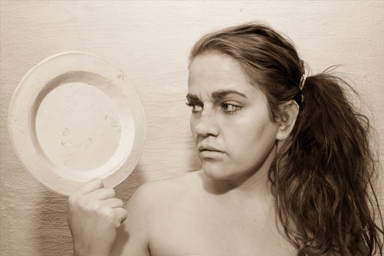
Pic right by SUZY BERNSTEIN: Newcomer Taryn Papadopoulos Louch prepares to smash some plates in Meze, Mira and Make-Up
As you enter the newly-redecorated foyer of the theatre, you won’t hear piped music.You’ll hear the give and take of waves and the call of seagulls. This balmy coastal sound ushers in Renos Spanoudes’ new play, Soil, directed by Lynne Maree and located in Cyprus.
The set’s plain blue door evokes Nikos Kazantzakis’ love affair with Greece through Zorba the Greek.
A man knocks on the door. He asks in stutteringly foreign Turkish if the property is still for sale. The woman in the house says no, she’s changed her mind. And then he takes off his sunglasses. She gasps. Quietly, subtly, she gasps. This look of recognition is pivotal to the play.
Soil hauntingly unpicks the complexity of land ownership in a world torn up by war. Spanoudes uses the Greek Orthodox icon as a tool to try and suture lives broken by politics. Eleftheria (Brenda Sakellarides) is the Turk; Nicolaos (Ashley Dowds) the Cypriot.
While you may not remember the 1974 Turkish invasion of North Cyprus, whether you come from Israel, Palestine or Zimbabwe, whether you lost family in Eastern Europe or Rwanda, you will know this emotional nub; you will recognise the need to allow each side the dignity of voice.
The message is predictable yet so well crafted that the discomfort in slapping questions of land ownership across the stage is accomplished elegantly and with authenticity.
The play stumbles with unnecessarily long transitions, with melodramatic chords thrumming. But maverick choreography and the wrapping of old photographs with an apple tree make Soil a rare and simple joy.
Irene Stephanou wrote and performed Meze, Mira and Make-Up in the 1980s. It’s a quirky and unrelentingly critical look at the social vagaries of growing up Greek in Roodepoort.
Like Spanoudes’ play, it is autobiographical; it’s a rollicking tale which stretches 20 years, from the birth of Kalomira, until her graduation, dished up with delicious swathes of 1970s nostalgia.
Stephanou’s persona is injected beautifully into the script. Directed by Spanoudes and introducing Taryn Papadopoulos Louch, the work resonates with a bitter-sweetness that makes the tragic plight of Van Gogh’s life hilarious without crassness or foolishness.
When Kalomira snaps from being a new-born with eyes like olives into a petulant unconfident 14-year-old struggling being Greek in South Africa, the hilarity begins.
Like Sonia Esquiera’s Porra plays, Meze holds up a culture fondly, but intact with all its flaws, its cringe-worthy petty racisms and its ability to celebrate itself, to the mirror of the audience. And while a little long, it’s lovely; you will be smitten by Papadopoulos Louch’s frank and inherent beauty.
Bak retrospective at Cape Jewish Museum
By: ROBYN COHEN
Recently Boston artist Samuel Bak made the decision not to travel with his exhibitions held in other countries. At the age of 80 and with three daughters living in Paris, he decided he would only travel if family is involved.
The internationally acclaimed artist is considered one of the pre-eminent painters of Holocaust themes. Although he doesn’t like being labelled a Holocaust painter, his work is very much rooted in his experiences (he was born in 1933); his life as a survivor and somehow trying to navigate it all.
When he heard that his work would be shown at the South African Jewish Museum in Cape Town, he immediately agreed to come out here as it involves family and it is an opportunity to unite with relatives – who are descendants from Lithuania and many of whom trace their roots to Vilna (now Vilnius), where he was born.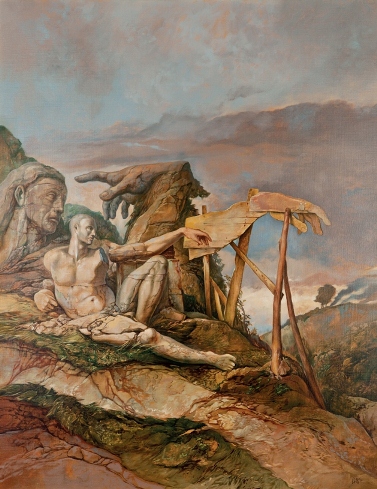
He only learned of the South African “cousins” as he puts it, about four years ago and in-between the exhibition, he will be meeting with them – many for the first time. The exhibition- a “Retrospective Journey into the Art of Samuel Bak” – opens on November 11.
RIGHT: Bak’s 1999 oil on canvas, Searching
I first heard about Samuel Bak 18 months ago when my husband and I visited the US. We stayed in Providence, Rhodes Island with our friends Robin Back and James Pugh. It was my first visit to the US and I was starry eyed and was asking about everything around me.
I spotted a book filled with images – by artist Samuel Bak – a name I did not recognise.
“Oh, he is our cousin,” said Robin, “and he is a famous artist with works in major collections in museums around the world.”
Robin told me that a few years before, his cousin, Charles Back and his wife Di were visiting the Jewish Museum in Vilnius. Charles owns Fairview Wine Estate and cheesery in Paarl and he and Di were in Vilnius to find out about their roots as the Back family had originally been from Lithuania.
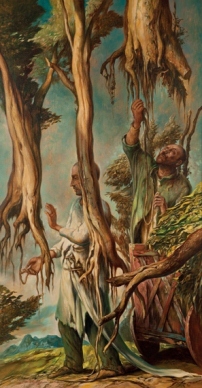 They knew that their name Back used to be Bak, but was anglicised when members of the family migrated to South Africa. Bak became Back.
They knew that their name Back used to be Bak, but was anglicised when members of the family migrated to South Africa. Bak became Back.
In the museum in Vilnius, Charles and Di noticed a poster, publicising the art of Samuel Bak.
They were told this was a famous artist who had been born in Vilna, who had been a child prodigy artist in the Vilna ghetto, had survived horrors of the ghetto and a labour camp and now lived in Boston.
LEFT: Samuel Bak’s 1996 oil
on linen, Culture of Roots
They had been told that all the Baks in Lithuania were related. It was like one big clan, so they phoned Samuel in Boston. It was literally – “Hello, we think we are family. We are from South Africa.”
Samuel had no idea about the South African branch and they had no idea about him.
Flip forward a few years later and when Samuel heard that an exhibition was imminent in Cape Town, he was delighted to come out here and meet the “cousins”. The bulk of the South African Jewish community arose from mass immigration from Lithuania, prior to the Second World War.
The community grew, but what was left behind was decimated. “The Lithuanian Jews had the highest number of people murdered in the Holocaust,” says Samuel. “About 95 per cent were wiped out. Other cousins looked for another world and they went to South Africa.”
On the phone from Boston, Samuel tells me that he has selected the 42 pieces for the Cape Town retrospective “on a thematic basis that relates to Jewish history in the 20th century, the Holocaust and my personal experiences”.
The selection spans almost 50 years – with work from when he was 13 to now and it includes works from his personal collection which have never previously been exhibited. As to the label Holocaust painter, he reflects: “I have an opposition to the idea of Holocaust art. There is good and bad art. I am not a Holocaust painter. My paintings are not depictions of the Holocaust. I’m offering an imagined view – imagined space and objects. I’m dealing with images as metaphors, allegories, symbols.”
He continues to make new work and early next year he will show what he terms his “cup paintings” at the Pucker Gallery in Boston. This body of work was inspired by an incident in the ghetto when Samuel (then age about nine) arrived to meet a famous artist. The artist was not there because he had been arrested and shot. All that remained on the wall was drawing of a boy and a cup.
Although he has used the cup in previous works, now he has focused on the image for the series. In some of the cup paintings the cup is just a cup. In others, it becomes a jail, a ruin, a container, home; a landscape of shards. It veers between being nurturing, demonic, celebratory and emblematic. 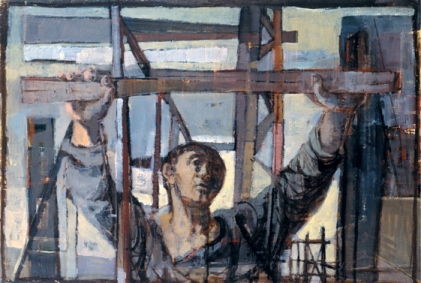
RIGHT: Samuel Bak’s 1955 Oil on canvas, Worker
He has been called a surrealist and one sees that – the exaggerated elements, the morphing and dissolving of one image into another. But then he will suddenly shift and toss in references to objects and images which surprise you – and reveal additional layers
His art is inextricably interwoven with a very complicated life, he muses and a lot of the debris of his life was brought to the surface when he was writing his memoirs, Painted in Word, published in 2002.
In the memoirs he talks about what drives him. It is complicated. From Boston he offers: “I think my main aim is to make people think and ask questions and question reality – the reality in which they live.”
* The South African Jewish Museum is open Sunday to Thursday 10:00 – 17:00 and Friday 10:00 – 14:00. It is closed Saturdays and Jewish holidays, but open public holidays. Tickets to the Samuel Bak Retrospective cost R40 and R25 for students and seniors. No charge for under-16s. Information: (021) 465-1546. The exhibition is on from November 11 until February 28.




